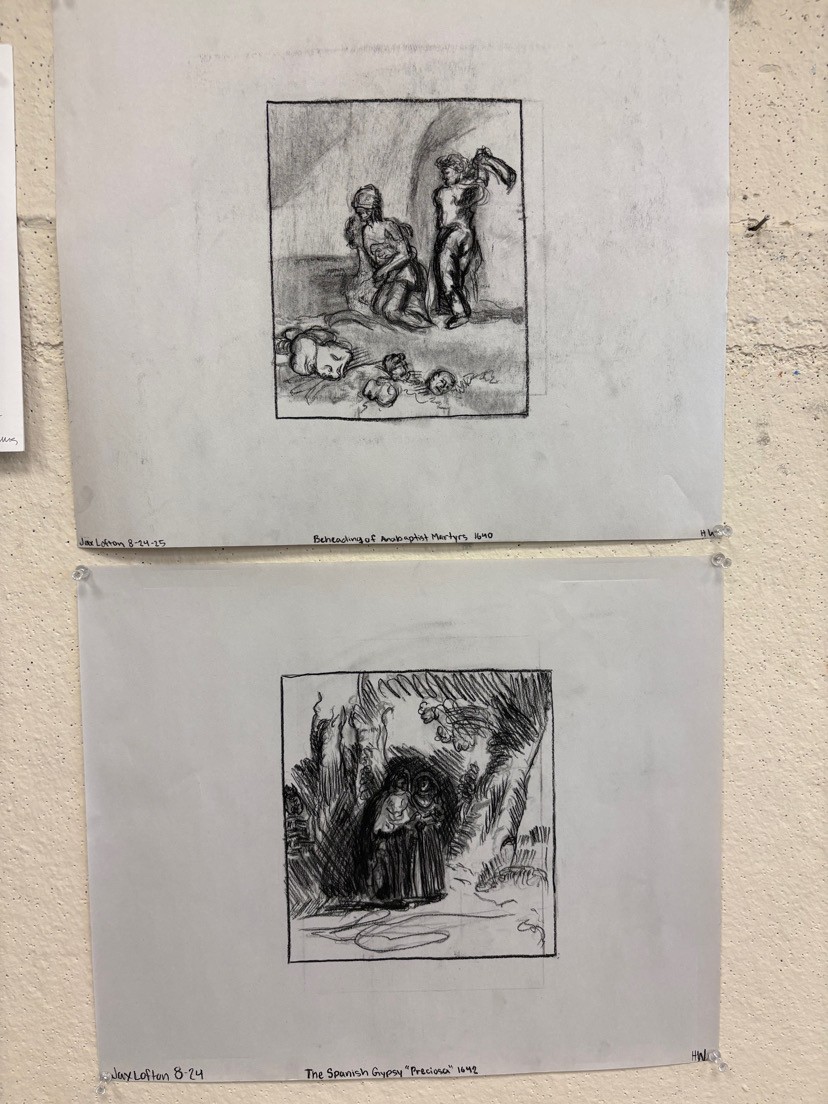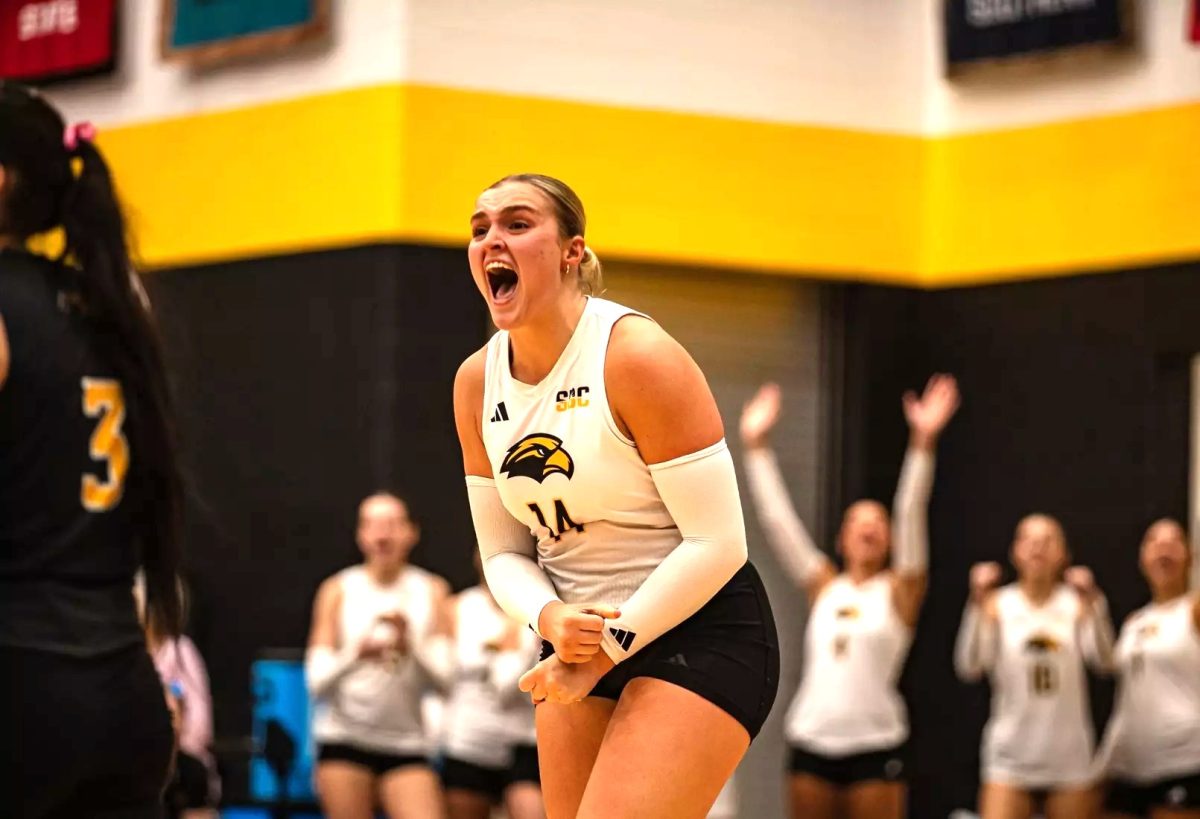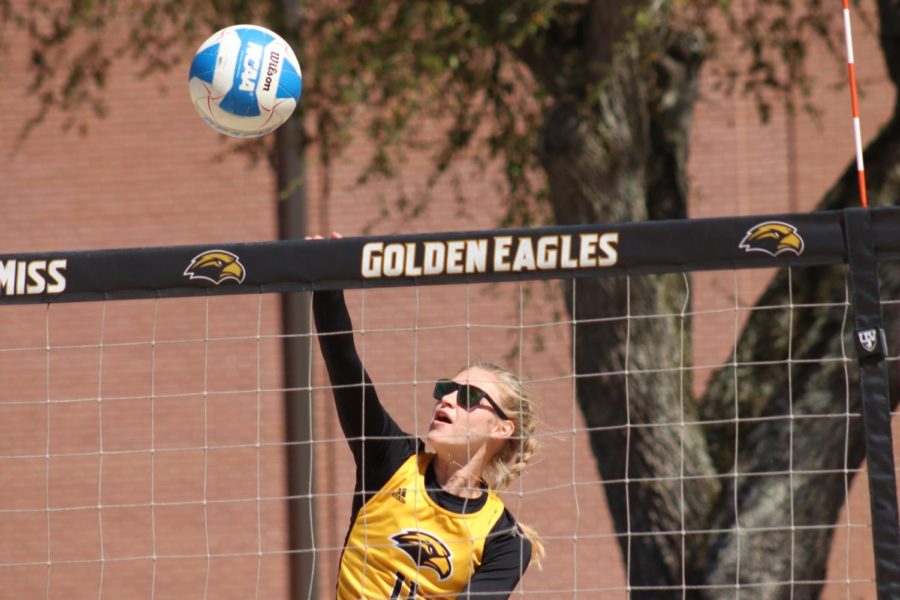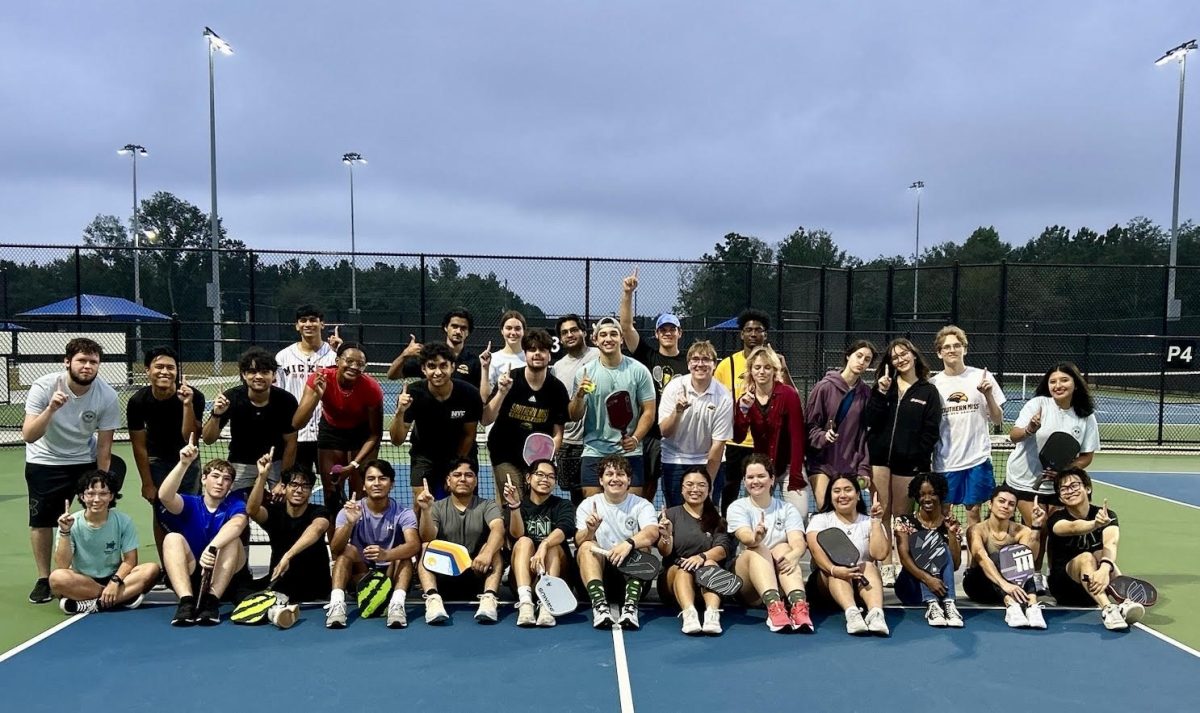USM students in 2017 may not realize Southern Miss housed not one but two live golden eagles on its Hattiesburg campus from 1980 – 1992.
Both birds Southern Miss obtained from the Department of Interior were injured and could not survive in the wild on their own, according to an archived Printz article. An organization can only obtain an eagle for educational purposes if it cannot survive in the wild on its own and must go through an application process to obtain an eagle on loan from the federal government, according to the Endangered Species Act of 1973.
After getting approval from the federal government, Nugget I lived on campus from 1980 – 1985 but was relocated due to health issues. After waiting a year for an eagle, USM received Nugget II in January of 1987.
Nugget II, meant to “inspire students and alumni with pride for their school,” according to an archived Printz article, met her demise from improper care by her student trainer. Almost 25 years ago, trainers awoke to find the second eagle gifted to Southern Miss, Nugget II, dead in the bottom of her aviary. The case went cold until 2013, when an investigative article by Sean Newell explored the nature of Nugget II’s death.
USM wants a live mascot
According to an archived Student Printz article from August 1980, The Southern Miss Alumni Association, in conjunction with the Alumni Student Board, directed efforts to obtain a live eagle for USM.
After going through the process to apply for the eagle and purchase negotiations with Auburn University’s Veterinary school, Southern Miss was granted a golden eagle to live on campus in 1980. According to an archived Student Printz article from Aug. 28, 1980, The USM Alumni Association handled the negotiations with Auburn Veterinary School of the purchase of a live eagle mascot for the 1980 fall semester.
“According to Dr. Tom Estes, vice president of business and finance, the bird has already been chosen, but they must receive a release from the U.S. Department of Interior before purchasing the bird,” the article said.
The Alumni Association raised funds to build the necessary housing and to purchase the injured eagle from Auburn’s rehabilitation center.
The three-and-a-half-year-old golden eagle arrived at USM’s campus in September 1980 after the government allowed USM to purchase the bird from Auburn. The government required the school to provide proper care and housing for the bird under the Endangered Species Act of 1973. The alumni association projected the eagle’s home to cost approximately $40,000.
In total, the aviary costed $12,000 more than the projected budget.
For almost a decade, with a brief interruption after the Nugget I’s departure from Southern Miss, an eagle resided in an aviary constructed by USM Physical Plant in 1980. Nugget received daily care from student trainers, whose qualifications consisted of “[possessing] a strong sense of responsibility, and they must be science majors enrolled at USM,” according to a Student Printz article published in 1985.
In 1986, care for both birds, construction of the aviary and purchase of both birds exceeded $100,000. The Alumni Association and the ASB raised funds for the purchase and care of the eagle through donations from alumni and others, with $5-6,000 being the average cost of care per year.
The aviary, which was built near the Speech and Hearing Building (the Dubard School), provided a pool, live tree and dead tree to accommodate Nugget’s needs. Construction on the aviary was projected at four months; however, due to weak materials that could not withstand Hattiesburg’s winds, the project took almost a year to complete, according to an archived Student Printz article from 1981.
The alumni association held a contest for naming the eagle with the deadline being the homecoming game. Nugget I debuted at USM’s homecoming game against Lamar University on Nov. 1, 1981.
Although the live mascot received support from Southern Miss alumni, many students strongly opposed the idea.
“Despite strong alumni support for the eagle, some student groups on campus are becoming increasingly vocal in their opposition,” the article said. “This week the biological honor society Beta Beta Beta announced they were against the prospect of exhibiting the eagle at games, rather than keeping it in a more natural environment and investigating the possibility that it could reproduce.”
A Student Printz opinion piece by Marisa Florentini commented on the exorbitant costs of housing an eagle on campus by writing a piece about the eagle “negotiating” with Aubrey Lucas, university president at the time.
“‘The Eagle has authorized me to make certain demands,’ the agent says,’” Florentini wrote. “‘First, he has told me that his living accommodations are intolerable A $40,000 bird cage, even with a swimming pool and tree, will not meet his needs. He has decided that if he is to stay, he must have his choice of rooms at President Lucas’ mansion.’
‘The bird can have a room at the Holiday Inn five days of the week and spend the weekends at my house.’”
Beta Beta Beta assumed correctly that Nugget I could reproduce, and in 1985 Nugget I became increasing difficult to care for as he was deemed a “mature” bird.
“Nugget is a sexually mature bird,” said Ron Phillips, assistant director of alumni activities in 1985. “We are looking to place Nugget in a breeding program at the University of Missouri.”
Five months later Southern Miss began its search for a replacement eagle, as Nugget I was sent to the Raptor Rehabilitation and Propagation Project in Eureka, Mo., which rehabilitated eagles for educational purposes.
Alleged mishandling of Nugget I and debut of Nugget II

Before Nugget I’s departure from USM, he suffered from a “40 percent enlarged talon,” according to an archived Student Printz article. His ex-trainer in 1986 Debbie Sims said Nugget I was allegedly not receiving the proper diet and this caused his talon to swell.
“Nugget’s ex-trainer [Sims], said she had difficulty communicating with the committee in charge of Nugget.
‘I ran into a lot of problems,” Sims said in 1986. ‘They wouldn’t listen to any proposals I had to give.”
Sims said she thought having a live golden eagle for USM’s mascot was a good idea, but the committee that ran the system was “more administrative than field workers.’”
According to Sims, Nugget’s kidney started to fail because his diet of lab rats was too high in protein, which could have been connected to Nugget’s swollen talon. Sims said when the shade put on Nugget’s cage blew down the Alumni Association did not put it back up until a federal agent called them. The article said Sims took matters into her own hands and called outside for help to care for the eagle, and the Alumni Association disagreed with her decision.
The Alumni Association and the committee charged with making decisions for Nugget I’s care allowed Sims to resign in January 1986.
However, the associate alumni director Phillips disagreed about Nugget being mishandled and attested that Sims felt “bigger than the university.” Phillips said no one can say we did not go first class on care for the eagle.
“Phillips said no conclusion was reached to prove that high protein was the cause of the swelling,” the article said in 1986. “We’ve always given enough money for the correct diet for the bird,’ Phillips said.”
Charles Blakeslee, one of Nugget’s veterinarians now living in North Carolina, said there were two things wrong with the bird.
“Nugget was a ‘maturing, aggressive male and it did have swellings in what would be comparable to a human’s ankles,’” the article said. “Blakeslee said the swelling may have been anything from gout to tendonitis and may have been caused by the bird’s diet. The lab raised rodents fed to the bird were not a balanced diet compared to natural rodents, according to Blakeslee.”
When Nugget I arrived at the Raptor Rehabilitation and Propagation Project in Eureka, Mo., the Project Coordinator of 1986 said Nugget arrived in “great shape.” Nugget was rehomed in the Atlanta County Zoo in Georgia, according to Gillett.
Two months later, USM announced it was on the waiting list to receive another eagle from the Department of Interior. Sept. 16, 1986. By January of 1987, Sharon Ward of USM public relations in 1987 announced a new mascot had been found in Hillsboro, Texas. The five-year-old eagle suffered a gunshot wound and was found by Al Jodoin, who held a license to fly golden eagles, according to an archived Printz article.
Nugget II arrived in Hattiesburg for training in March and made her debut at the Birmingham Game on Sept. 3, 1987. Nugget II made no more headlines until her untimely death in 1992.
Nugget II dies
On Dec. 6, 1986, student trainers found Nugget II dead in the bottom of her aviary. Nugget II had a shotgun wound and many believed she had died from lead poisoning. Eagles are protected by the government. Killing one could result in a felony charge and maximum fine of $250,000. The Student Printz ran ads that offered a $4,500 reward for any information regarding Nugget II’s death.
However, the necropsy revealed that the injury was sustained “in the distant past” and could have been the wound she obtained before arriving at USM, according to Newell. Nugget II was sent to Wisconsin for an official necropsy by the Department of Interior. The necropsy revealed Nugget II was emaciated and did not die from lead poisoning.
In Newell’s 2013 investigative article, he obtained the necropsy report. The university president at the time Aubrey Lucas released an official statement in 1993 which said Nugget II’s death was caused by malnutrition due to improper care. However, Newell believed otherwise and investigated the case further.
According to Newell, Nugget II’s handler, who was a registered falconer, withdrew from USM and was replaced by an inexperienced student handler. Newell said Federal Investigator Bob Oliveri contacted both handlers and found that Nugget II was not being fed, contrary to USM’s official statement.
The necropsy said “the eagle was in good health and eating before the trainer withdrew from the university.” According to the report there was no evidence of infectious disease, four shotgun pellets had been removed from the eagle and “no associated hemorrhaging, inflammation or bony callus was found, indicating that the shooting occurred more than six months prior to the eagle’s death.”
According to the necropsy, the handler did not keep records, report to anyone official over Nugget II’s care and never received training to handle the bird. The new handler went home for Thanksgiving break and said he had made arrangements for Nugget II to be fed while he was away.
“He did not feed Nugget II upon his return that night, nor did he feed him at any point in the three days prior to the discovery of the Golden Eagle’s carcass, on Dec. 6. New Handler ‘could not remember when [he] last fed the eagle,’” according to the report.
Newell concluded that Nugget II had not been fed for a full week before her death and the necropsy confirmed this suspicion.
According to the necropsy, the caretaker stated that they had returned to campus on Nov. 29, 1992 and did not feed the bird that night.
“[The caretaker] said they did not feed Nugget II 12/3, 12/4 or 12/5,” the necropsy said. “The eagle was found dead on Dec. 6, 1992. [The caretaker] could not remember when they last fed the eagle.”
USM now faced possible charges from the U.S. attorney general, but they were never brought against the university.
According to Newell, in June 1993 a check was cut to the U.S. Treasury and USM forfeited its permit allowing the university to have an eagle on campus. Newell wrote that the handler was never charged for his part in Nugget II’s death. Southern Miss attempted to get another eagle on campus, but it was never approved by the federal government.
“Treasured Past, Golden Future: The Centennial History of The University of Southern Mississippi” written by Southern Miss historian Chester M. Bo said “the university paid a fine of $5,000 to the U.S. Fish and Wildlife Service and to the National Fish and Wildlife foundation constituted, the university insisted, an admission of responsibility but not guilt.”
USM forms partnership with Hattiesburg Zoo
In November 2013, the Alumni Association formed a partnership with the Hattiesburg Zoo to obtain another golden eagle on loan from the federal government. According to the Hattiesburg Zoo, the Alumni Association, Student Government Association and USM Foundation raised more than $70,000 to get the eagle and “fund the construction of the habitat for the eagle at the Hattiesburg zoo.” The bird was also named Nugget as an unofficial Nugget III.
“The partnership between the Hattiesburg Zoo and the Alumni Association to bring a golden eagle to Hattiesburg is a winning combination,” said Rick Taylor, executive director of the Hattiesburg Convention Commission which oversees the management of the Zoo in a 2013 press release. “These powerful raptors exemplify the spirit of Southern Miss and Hattiesburg as we each seek to attain great heights in building a better quality of life for students and residents.”
The zoo underwent the same rigorous application process in order to house the eagle in Hattiesburg and the one selected for the partnership was injured in Ojai, Cali. According to the zoo, the staff received more than 300 hours of training at Auburn University’s Raptor Rehabilitation Center. The zoo invited Southern Miss football fans, alumni and students to the debut of the eagle’s habitat on Nov. 24, 2013.
Less than three months later In 2014, the Hattiesburg Zoo obtained another eagle from the same rehab facility in California to live with Nugget. The zoo held a contest to name the second eagle and Talon was chosen.
According to the zoo, Nugget is not allowed to travel to USM’s campus for football games or leave the zoo’s premises. Nugget III still resides at the Hattiesburg Zoo under the sponsorship of the Alumni Association, SGA and USM Foundation.
The 25th anniversary of Nugget II’s death illuminates a dark history of Southern Miss, but the partnership made between the university and the zoo to care for and respect all life suggests a bright future.






































